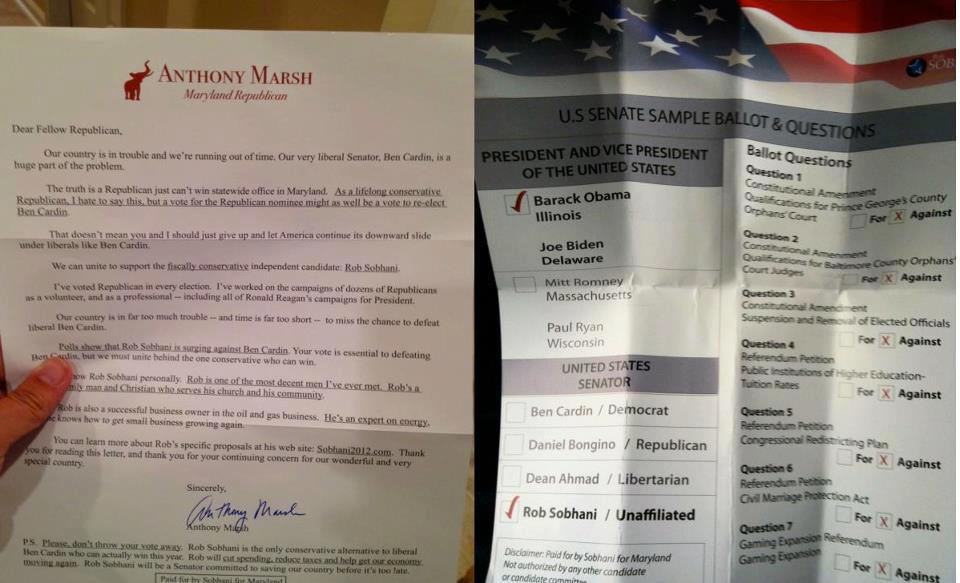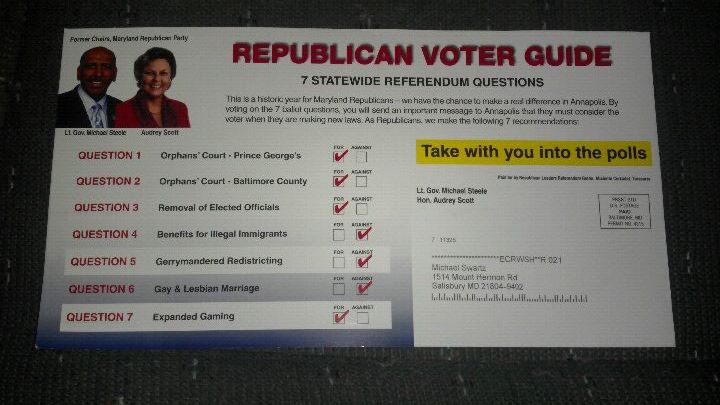The question expressed in the title is perhaps the most vital one going forward for Maryland Republicans. Some are already arguing the state is a lost cause, and when your state’s winning Presidential write-in is Santa Claus (yes, Santa was an official write-in candidate so his votes counted) it’s pretty likely that too many expect things from the government.
In 2012 there were two statewide candidates bearing the Republican ticket and two Libertarians. While the circles aren’t perfectly together, if you made a Venn diagram there would be a lot of common ground and that percentage could make a difference someday. So for the sake of this argument I’m adding them together.
- President: Mitt Romney 971,869 + Gary Johnson 30,195 = 1,002,064 (37%)
- U.S. Senate: Dan Bongino 693,291 + Dean Ahmad 32,252 = 725,543 (27.5%)
Arguably, of the two Republicans the case can be made that Bongino was the more conservative while Romney was perceived by most as relatively centrist (and the closer he got to the end of the campaign, the more he drifted toward the center.) But in that Senate race there was the third man, and polling suggests that for every two votes he took from Democrat Ben Cardin he took three from Dan Bongino. Add 60% of Rob Sobhani’s total to this mix and you have 984,103. Figure in the 2.7% undervote on the Senate race as compared to the Presidential one and it looks like the current conservative/libertarian ceiling is about 1 million votes statewide.
So let’s say that 1,000,000 is the magic number. If our side had turned out 1,000,000 votes for each past statewide election:
- The 2010 statewide elections for Governor and Comptroller would have been nailbiters rather than over by 30 minutes after the polls closed.
- Those elections would have been for an open gubernatorial seat because Bob Ehrlich would have been re-elected in 2006. Michael Steele would have ran this year as an incumbent, and the other two statewide races would have been agonizingly close losses.
You’ll notice that these are gubernatorial cycles rather than Presidential – simply put, 1 million votes in Maryland won’t win in a Presidential year. The only GOP candidate to ever exceed 1 million here was George W. Bush in 2004 and he was running as an incumbent (and still lost big.)
So the trick is getting the same base which comes out to vote in the Presidential election to participate in the gubernatorial ones. But at the same time we have to expand our share of the pie somewhat to be more competitive in Presidential races rather than having GOP campaigns write Maryland off as a lost cause before the campaign even begins.
While there is a share of the electorate which has as its focus a single issue (generally social issues like abortion or gay marriage, although this extends to items like Second Amendment issues or property rights) most people vote their pocketbook and unfortunately they’ve come to grudgingly accept that the government is going to take more out of their pocket regardless of how much they complain. After all, in 2010 – during a TEA Party wave election – Maryland voters re-elected a governor who had raised taxes on practically everyone. But Martin O’Malley successfully pushed the message that “a fee is a tax” and could paint his GOP opponent Bob Ehrlich with the same brush. (O’Malley and General Assembly Democrats then merrily went on to raise many of those same fees.)
Yet at the same time a growing proportion of these voters have become recipients of these same government handouts the increased taxes pay for, creating a situation where redistribution of wealth is the means by which the majority party maintains power. After all, when over half depend on government for their well-being then those in charge of the government tend to stay in charge.
Somewhere we have allowed the opposition to paint us as heartless government cutters. And the other problem is that telling people that “it’s your money” doesn’t work as well when they receive the money from a governmental unit. That doesn’t have to be the ever more ubiquitous EBT card – it can be employment by a governmental unit, whether city hall, the local school, or any of the thousand other bureaus, agencies, or even nonprofits which depend on government grants for their existence. Remember, that cop on the street, your child’s public school teacher, or the lady at the MVA are all government employees, but so is the Salisbury University professor or – indirectly – the grant writer at the nonprofit. Nearly all of them have a vested interest in making sure the taxpayer money spigot remains flowing, because many are scared by the common media narrative into believing the TEA Party is going to leave them high and dry.
Indeed, there are certain cases where they could be correct. But one argument I wish Dan Bongino could have amplified more, because it was effective, ran along the lines (I’m paraphrasing from memory) of being happy to pay for the cop on the street, the public school teacher, or the soldier in Afghanistan – but he drew the line at cowboy poetry festivals in Nevada.
Obviously one can argue the merits of a project which benefits one small area – the drought-stricken farmer in Indiana whose subsidized disaster assistance we criticize may feel the same way about Ocean City beach replenishment here. Moreover, those are small potatoes compared to the huge entitlement spending begging to be cleaned up on the federal level.
But we have to start small and gain trust, particularly when it comes to state politics. For all his tax-raising faults and sacrificing the needs of his state in order to pursue the personal gain of higher office, Martin O’Malley is not an unpopular governor. Arguably this could be due to plenty of help from a sympathetic media, but he’s used the state’s better-than-average unemployment rate (thanks to adjacency to the seat of federal government) to convey the message that all is well. Those who have differing opinions don’t have the same blowtorch to get the message out – 25,000 Facebook followers for Change Maryland is great but hundreds of thousands of Marylanders subscribe to the Baltimore Sun and Washington Post. While I wish to have thousands of readers a day and believe my message is worth the readership, I don’t reach that many with this little candle of mine – it’s no blowtorch quite yet. To be quite blunt, if you took the unique daily readership of ALL the political blogs which deal with Maryland politics – even including their attempts at multimedia – and added them all together, you might equal the readership of a regional newspaper like the Daily Times. As it stands at present, we’re the guppies in an ocean of media, and we have to work at expanding that sphere of influence as well.
Yet the very argument we have a winning message remains untested. Perhaps Dan Bongino was a nearly perfect spokesperson for a conservative message, but there were factors which affected his Senate bid: a perceived lack of life and business experience compared to his opponents, and the fact that one opponent ran a populist campaign with non-specific promises no one forced him to flesh out. Rob Sobhani wanted the debates and so did we, but Hurricane Sandy had other plans for our state and hard questions weren’t asked.
Yet even if Bongino had ran his 2012 race unmolested, the probability is strong he would have picked up around the same 36 to 37 percent which has seemed to be our ceiling in Presidential years. We have to convince about 300,000 more voters in a Presidential year that – assuming we have a conservative, pro-liberty candidate, of course – it’s in the best interests of both them and succeeding generations to cast their ballot for such a person. In one lump, that seems like a lot, but it really only takes a handful of politically agnostic neighbors or friends per activist to accomplish.
In the near future, 2014 is looming and there are at least four candidates who are looking for conservative, pro-liberty support (although they may or may not necessarily have a compatible message: think Bob Ehrlich.) Yet the same rules apply; as I demonstrated earlier getting 1 million votes in a gubernatorial year keeps us at least close and climbing the ladder for another 100,000 may put us over the top.
Yet we cannot rely on a politician – even one as articulate as Dan Bongino – to deliver our message for us. It’s time for all of us to do our part, even though many of us are still burned out on the lengthy 2012 campaign and the disappointment we feel with the results. Indeed, we lost this time but there’s always the next election. Spread the word that we CAN win!



